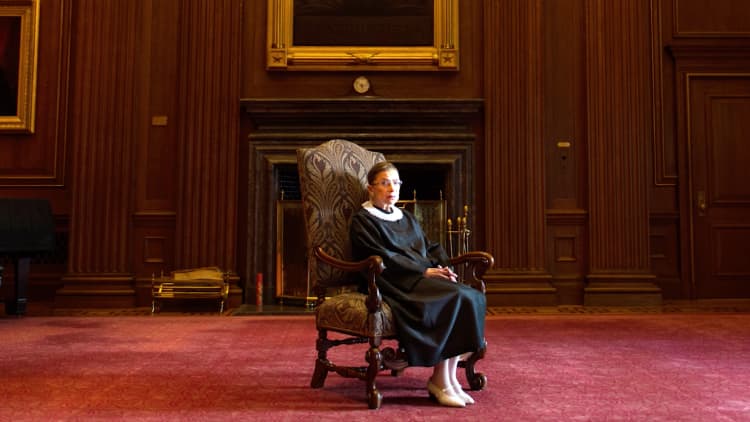
WASHINGTON – Supreme Court Justice Ruth Bader Ginsburg was not on the bench on Monday to hear arguments in the first case brought to the high court since she underwent cancer surgery last month.
Ginsburg, 85, has not missed a day of argument since President Bill Clinton appointed her to the bench 25 years ago. This is believed to be the first time she has missed a day for any reason outside of recusal.
In a brief address at the start of the court session Monday, Chief Justice John Roberts said Ginsburg was "unable to be present today" but added that she will still participate from home. The court then proceeded to hear arguments in the first case of the day.
A court spokesperson said earlier in the day that Ginsburg would participate in Monday's cases "on the basis of briefs, filings and transcripts."
It is not clear when Ginsburg will return to the court. The court has arguments scheduled Tuesday and Wednesday. The justices will meet in a private conference Friday.
Despite that participation, Ginsburg was not expected to be able to ask questions Monday. That is significant, since Ginsburg is one of the court's most consistent questioners. Last term, Ginsburg spoke at least once during every oral argument, according to an analysis by Empirical SCOTUS, one of only three justices to do so.
Ginsburg's surgery to remove two cancerous growths from her left lung took place Dec. 21 at Memorial Sloan Kettering Cancer Center in New York. The court said following the operation that there was no evidence of remaining disease and that no further treatment was planned. She was discharged Dec. 25, the court said.
Her attendance streak is formidable. It continued through surgery and radiation in the late 1990s for colorectal cancer, surgery in 2009 for pancreatic cancer, a heart procedure in 2014, and two falls that resulted in broken bones, including one late last year. She did not miss a day of argument while her husband was treated for the cancer that ultimately took his life in 2010.
Ginsburg's health has been a matter of intense public interest because her retirement would likely allow President Donald Trump to appoint her successor. The nine-member court is divided 5-4 among Republican and Democratic appointees.
An appointment by Trump, which would be the third of his presidency, would further cement the bench's conservative majority, with possible ramifications for a slew of closely watched social issues such as reproductive rights.
On the day of Ginsburg's latest surgery, Trump wished the justice a "full and speedy recovery" in a post on Twitter.
Monday's first case, Merck Sharp & Dohme Corp. v. Albrecht, No. 17-290, involves warning labels on pharmaceuticals. The second case of the day is Obduskey v. McCarthy & Holthus, LLP, No. 17-307, concerning whether the Fair Debt Collection Practices Act applies to nonjudicial foreclosure proceedings.
The Supreme Court remains open despite a partial government shutdown, which was in its 17th day Monday. A long line of visitors streamed into the court building on Monday while other attractions, such as the National Zoo and the Smithsonian museums, shut their doors.


